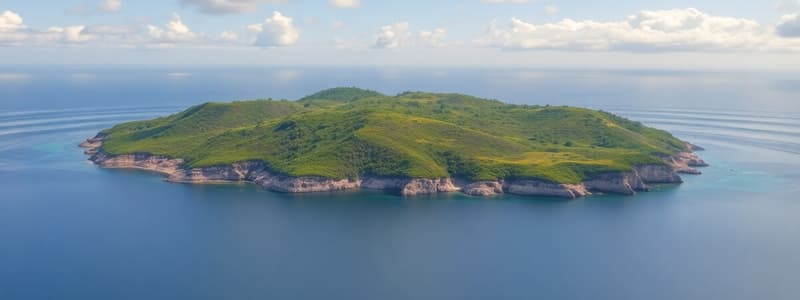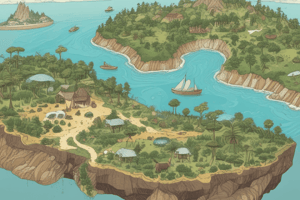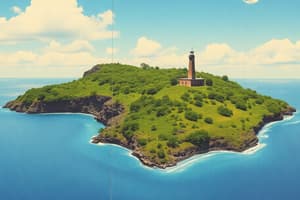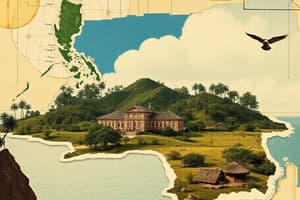Podcast
Questions and Answers
How does island size generally correlate with species richness, according to studies in geographic ecology?
How does island size generally correlate with species richness, according to studies in geographic ecology?
- Larger islands tend to support more species than smaller islands. (correct)
- Species richness is inversely proportional to island area.
- Island size has no predictable effect on species richness.
- Smaller islands tend to have higher species richness due to edge effects.
What did MacArthur define geographic ecology as?
What did MacArthur define geographic ecology as?
- The application of ecological principles to urban planning.
- The search for patterns of plant and animal life that can be mapped. (correct)
- The analysis of genetic diversity within isolated populations.
- The study of evolutionary relationships among species across different continents.
Which factor, besides area, most significantly affects species richness on islands?
Which factor, besides area, most significantly affects species richness on islands?
- The degree of isolation from other landmasses. (correct)
- The average annual rainfall of the island.
- The primary soil type found on the island.
- The presence of specific keystone predators.
What broad geographic patterns are central to the study of geographic ecology?
What broad geographic patterns are central to the study of geographic ecology?
How did climate warming at the end of the Pleistocene affect habitat distribution in the American Southwest?
How did climate warming at the end of the Pleistocene affect habitat distribution in the American Southwest?
What was the focus of Arrhenius's early work that contributed to the field of geographic ecology?
What was the focus of Arrhenius's early work that contributed to the field of geographic ecology?
What does the concept of 'mountain islands' refer to in the context of habitat patches on continents?
What does the concept of 'mountain islands' refer to in the context of habitat patches on continents?
Which of the following statements best describes the influence of historical processes on regional biodiversity?
Which of the following statements best describes the influence of historical processes on regional biodiversity?
How does the equilibrium model of island biogeography explain species diversity patterns on islands?
How does the equilibrium model of island biogeography explain species diversity patterns on islands?
What general trend is observed when comparing lake area and fish species richness, based on the studies mentioned?
What general trend is observed when comparing lake area and fish species richness, based on the studies mentioned?
Why might pteridophyte diversity on islands be less affected by isolation compared to bird diversity?
Why might pteridophyte diversity on islands be less affected by isolation compared to bird diversity?
How does the concept of habitat islands apply to montane vegetation and mammal distributions?
How does the concept of habitat islands apply to montane vegetation and mammal distributions?
What is the expected impact on the immigration rate of new species as a new island gradually becomes populated?
What is the expected impact on the immigration rate of new species as a new island gradually becomes populated?
Based on the principles of island biogeography, which of the following scenarios would likely result in the lowest species richness?
Based on the principles of island biogeography, which of the following scenarios would likely result in the lowest species richness?
According to the equilibrium model of island biogeography, what primarily determines the rate of immigration to an island?
According to the equilibrium model of island biogeography, what primarily determines the rate of immigration to an island?
Why does the equilibrium model predict that extinction rates increase with the number of species on an island?
Why does the equilibrium model predict that extinction rates increase with the number of species on an island?
Lomolino et al.'s study of montane mammal species on mountaintops in the American Southwest revealed a strong negative relationship between isolation and species number. What does this suggest about the factors influencing montane mammal diversity?
Lomolino et al.'s study of montane mammal species on mountaintops in the American Southwest revealed a strong negative relationship between isolation and species number. What does this suggest about the factors influencing montane mammal diversity?
According to the equilibrium model, which type of island would be expected to support the fewest number of species?
According to the equilibrium model, which type of island would be expected to support the fewest number of species?
According to MacArthur and Wilson's findings on Pacific Islands, what is the primary effect of isolation on bird diversity?
According to MacArthur and Wilson's findings on Pacific Islands, what is the primary effect of isolation on bird diversity?
What does the concept of 'species turnover' on islands refer to, as predicted by the equilibrium model?
What does the concept of 'species turnover' on islands refer to, as predicted by the equilibrium model?
In the Simberloff and Wilson experiment, what was the significance of using mangrove islands as 'controls'?
In the Simberloff and Wilson experiment, what was the significance of using mangrove islands as 'controls'?
What was the primary observation made on the defaunated mangrove islands in the Simberloff and Wilson experiment?
What was the primary observation made on the defaunated mangrove islands in the Simberloff and Wilson experiment?
How did Rydin and Borgegård's findings contribute to the understanding of island biogeography?
How did Rydin and Borgegård's findings contribute to the understanding of island biogeography?
Consider two islands: Island A is large and near the mainland, while Island B is small and far from the mainland. According to the principles of island biogeography, which of the following statements is most likely to be true regarding their equilibrium number of species?
Consider two islands: Island A is large and near the mainland, while Island B is small and far from the mainland. According to the principles of island biogeography, which of the following statements is most likely to be true regarding their equilibrium number of species?
What is the relationship between species diversity and habitat heterogeneity in diverse communities?
What is the relationship between species diversity and habitat heterogeneity in diverse communities?
Which of the following factors contributes to the higher species richness observed in tropical environments compared to high latitude environments?
Which of the following factors contributes to the higher species richness observed in tropical environments compared to high latitude environments?
According to one hypothesis, what primary factor limits tropical species compared to physical factors?
According to one hypothesis, what primary factor limits tropical species compared to physical factors?
If the rate of speciation increases and the rate of extinction decreases in an area, what is the likely outcome regarding the number of species in that area?
If the rate of speciation increases and the rate of extinction decreases in an area, what is the likely outcome regarding the number of species in that area?
How does greater land area in the tropics contribute to higher species richness, according to Terborgh and Rosenzweig?
How does greater land area in the tropics contribute to higher species richness, according to Terborgh and Rosenzweig?
What effect do larger species ranges have on allopatric speciation rates?
What effect do larger species ranges have on allopatric speciation rates?
In the context of latitudinal gradients in species richness, if immigration is discounted at large scales, what are the two primary processes that determine the number of species in an area?
In the context of latitudinal gradients in species richness, if immigration is discounted at large scales, what are the two primary processes that determine the number of species in an area?
Why might physically extreme environments restrict diversity?
Why might physically extreme environments restrict diversity?
Simberloff's experiment on mangrove islands primarily demonstrated what relationship between island area and species richness?
Simberloff's experiment on mangrove islands primarily demonstrated what relationship between island area and species richness?
What is a key difference observed in species accumulation between small/medium islands and large islands?
What is a key difference observed in species accumulation between small/medium islands and large islands?
The latitudinal gradient in species richness refers to which pattern?
The latitudinal gradient in species richness refers to which pattern?
Which of the following best describes the 'Time Since Perturbation' hypothesis for latitudinal gradients in species richness?
Which of the following best describes the 'Time Since Perturbation' hypothesis for latitudinal gradients in species richness?
According to the 'Productivity' hypothesis, how does high productivity contribute to high species richness?
According to the 'Productivity' hypothesis, how does high productivity contribute to high species richness?
Why is it difficult to separate the effects of habitat diversity from area effects when studying island biogeography?
Why is it difficult to separate the effects of habitat diversity from area effects when studying island biogeography?
If an island's area is reduced by 50% as part of an experimental manipulation, what is the most likely immediate effect on the island's species richness?
If an island's area is reduced by 50% as part of an experimental manipulation, what is the most likely immediate effect on the island's species richness?
Which of the following statements accurately reflects Connell's (1978) proposition regarding disturbance and tropical diversity?
Which of the following statements accurately reflects Connell's (1978) proposition regarding disturbance and tropical diversity?
Flessa and Brown's research indicated which relationship between continental area and species richness?
Flessa and Brown's research indicated which relationship between continental area and species richness?
Which factors did Bond and Goldblatt attribute to the unusually high species richness in the Cape Floristic Region of South Africa?
Which factors did Bond and Goldblatt attribute to the unusually high species richness in the Cape Floristic Region of South Africa?
Why do temperate forests in Europe have lower tree species richness compared to those in Eastern Asia and Eastern North America, despite having roughly equal areas?
Why do temperate forests in Europe have lower tree species richness compared to those in Eastern Asia and Eastern North America, despite having roughly equal areas?
How did Rosenzweig's findings expand upon the understanding of the relationship between area and species richness?
How did Rosenzweig's findings expand upon the understanding of the relationship between area and species richness?
What conclusion can be drawn from the comparison of tree species richness in temperate forests of Europe, Eastern Asia, and Eastern North America?
What conclusion can be drawn from the comparison of tree species richness in temperate forests of Europe, Eastern Asia, and Eastern North America?
In which region did Ralph (1985) find a negative correlation between foliage height diversity and bird species diversity?
In which region did Ralph (1985) find a negative correlation between foliage height diversity and bird species diversity?
The Cape region of South Africa and the California Floristic Province are both biodiversity hotspots, but the Cape region exhibits higher species richness despite being smaller. What does this suggest about the factors influencing species diversity?
The Cape region of South Africa and the California Floristic Province are both biodiversity hotspots, but the Cape region exhibits higher species richness despite being smaller. What does this suggest about the factors influencing species diversity?
Which of the following scenarios would most likely lead to increased species richness in a given region over long periods of time?
Which of the following scenarios would most likely lead to increased species richness in a given region over long periods of time?
Flashcards
Geographic Ecology
Geographic Ecology
The study of ecological structure and process at large geographic scales.
Island Biogeography Key Concept
Island Biogeography Key Concept
Species richness increases with area and decreases with isolation.
Arrhenius
Arrhenius
Developed quantitative relationship between area and number of species.
Island Area and Species Richness
Island Area and Species Richness
Signup and view all the flashcards
Latitudinal Gradients in Species Richness
Latitudinal Gradients in Species Richness
Signup and view all the flashcards
Preston
Preston
Signup and view all the flashcards
Mountain Islands
Mountain Islands
Signup and view all the flashcards
Long-term Historical and Regional Processes
Long-term Historical and Regional Processes
Signup and view all the flashcards
Montane Habitat Islands
Montane Habitat Islands
Signup and view all the flashcards
Lake Area and Species Richness
Lake Area and Species Richness
Signup and view all the flashcards
Island Isolation and Diversity
Island Isolation and Diversity
Signup and view all the flashcards
Montane Isolation Effects
Montane Isolation Effects
Signup and view all the flashcards
Island Biogeography
Island Biogeography
Signup and view all the flashcards
Immigration Rate on new Islands
Immigration Rate on new Islands
Signup and view all the flashcards
Declining Immigration Rate
Declining Immigration Rate
Signup and view all the flashcards
Equilibrium Model of Island Biogeography
Equilibrium Model of Island Biogeography
Signup and view all the flashcards
Equilibrium Model
Equilibrium Model
Signup and view all the flashcards
Extinction Rate Factors
Extinction Rate Factors
Signup and view all the flashcards
Species Number Prediction
Species Number Prediction
Signup and view all the flashcards
Island Biogeography Drivers
Island Biogeography Drivers
Signup and view all the flashcards
Species Turnover
Species Turnover
Signup and view all the flashcards
Island type Vs number of species
Island type Vs number of species
Signup and view all the flashcards
Stable Equilibrium Effect
Stable Equilibrium Effect
Signup and view all the flashcards
Area and Species richness
Area and Species richness
Signup and view all the flashcards
Island Area Effect
Island Area Effect
Signup and view all the flashcards
Simberloff's Experiment
Simberloff's Experiment
Signup and view all the flashcards
Latitudinal Gradient
Latitudinal Gradient
Signup and view all the flashcards
Time Since Perturbation
Time Since Perturbation
Signup and view all the flashcards
Productivity Hypothesis
Productivity Hypothesis
Signup and view all the flashcards
Glaciation Impact
Glaciation Impact
Signup and view all the flashcards
Connell's Disturbance Hypothesis
Connell's Disturbance Hypothesis
Signup and view all the flashcards
Species Richness
Species Richness
Signup and view all the flashcards
Environmental Heterogeneity Hypothesis
Environmental Heterogeneity Hypothesis
Signup and view all the flashcards
Favorableness Hypothesis
Favorableness Hypothesis
Signup and view all the flashcards
Biological Interactions Hypothesis
Biological Interactions Hypothesis
Signup and view all the flashcards
Speciation and Extinction Rates
Speciation and Extinction Rates
Signup and view all the flashcards
Tropical Speciation/Extinction
Tropical Speciation/Extinction
Signup and view all the flashcards
Area Hypothesis
Area Hypothesis
Signup and view all the flashcards
Species Ranges and Speciation
Species Ranges and Speciation
Signup and view all the flashcards
Allopatric Speciation
Allopatric Speciation
Signup and view all the flashcards
Area and Richness
Area and Richness
Signup and view all the flashcards
Cape Region Anomaly
Cape Region Anomaly
Signup and view all the flashcards
Cape's Richness Factors
Cape's Richness Factors
Signup and view all the flashcards
Temperate Forest Diversity
Temperate Forest Diversity
Signup and view all the flashcards
European Mountains' Impact
European Mountains' Impact
Signup and view all the flashcards
Extinction and Richness
Extinction and Richness
Signup and view all the flashcards
Foliage Diversity vs. Birds
Foliage Diversity vs. Birds
Signup and view all the flashcards
Historical & Geographic Influences
Historical & Geographic Influences
Signup and view all the flashcards
Study Notes
- Geographic ecology is defined as the search for patterns of plant and animal life that can be mapped.
- Geographic ecology studies ecological structure and process at large geographic scales.
Area, Isolation, and Species Richness
- Arrhenius developed the quantitative relationship between area and the number of species.
- Area and island size are related to the number of species found on the island.
- Fewest bird species live on the smallest islands, and the most species on the largest islands.
- Island area is the best single species richness predictor for woody plants, carabid beetles, and land snails.
- Forest and alpine habitats contracted to mountaintops across the American Southwest due to climate warming at the end of the Pleistocene epoch.
- Tonn and Magnuson studied Wisconsin lakes.
- The number of species increases with the area of the lake
- Lakes can be considered habitat islands.
- Barbour and Brown used 70 lakes from around the world to find a positive relationship between area and fish species richness.
- MacArthur and Wilson found that isolation reduces bird diversity on Pacific Islands.
- Birds and pteridophytes have increased diversity with increasing island area in the Azore and Channel Islands.
- Bird diversity is influenced by isolation, but pteridophyte diversity is not, reflecting differences in dispersal abilities (pteridophytes produce light spores).
- Lomolino et al. looked at montane mammal species on mountaintops across the American Southwest.
- A strong negative relationship was discovered between isolation and species number, suggesting that immigration is important in maintaining diversity.
Equilibrium Model of Island Biogeography
- MacArthur and Wilson explained the equilibrium model of island biogeography, explaining patterns of species diversity on islands due to the balance of immigration and extinction rates.
- Immigration rates would be highest on a new island with no organisms.
- As species accumulate, the rate of immigration declines as fewer arrivals are new species.
- The extinction rate rises with an increasing number of species on an island for three reasons.
- More species increases the pool of potential extinctions.
- As the number of species increases, the population size of each must diminish.
- As the number of species increases, the potential for competitive interactions between species increases.
- The point where the immigration and extinction lines cross predicts the number of species that will occur on an island.
- Immigration rate mainly determined by source distance from source of immigrants.
- Extinction rate is determined mainly by island size.
- Large near islands support the highest number of species.
- Small far islands support the lowest number of species.
- Small near and large far islands support intermediate species numbers.
- The equilibrium model predicts that species composition on islands is dynamic, referred to as species turnover.
- Diamond found birds in nine Calif. Channel Islands in a stable equilibrium due to approximately equal numbers of immigrations and extinctions.
- Species turnover occurs at a stable equilibrium.
- Simberloff and Wilson studied insect recolonization in the Florida Keys by using two mangrove islands as controls and six mangrove islands that were defaunated.
- The mangroves were tracked for one year.
- The mangrove island control species number was constant and its composition changed and the defaunated islands nearly returned to original species numbers.
- Rydin and Borgegård found that variation in species richness correlated positively with island area explaining 44 to 85% of species richness variation among islands.
- Small and medium islands continued to accumulate species, whereas large islands attained equilibrium.
- Simberloff tested the effect of island area on species richness in mangrove islands by reducing the area of some islands and leaving others as controls.
- In cases where area was reduced, species richness decreased (and richness on the control island increased slightly).
- Islands with reduced area lost species with each area reduction.
- Area has a positive influence on species richness.
Latitudinal Gradients in Species Richness
- Species richness generally increases from middle and high latitudes to the equator.
- The pattern of increased species in the tropics is pervasive and dramatic.
- Brown (1988) grouped hypotheses into six categories.
- The tropics are older and disturbed less frequently, allowing for more time for speciation and reducing the extinction rate.
- Less frequent disturbance reduces the extinction rate.
- High productivity contributes to high species richness due to more energy to divide among populations.
- Tropics have more species because they are more heterogeneous.
- Tropics provide more favorable environments due to less temperature variation when compared with high latitudes.
- Tropical species are limited more by biological factors than physical factors.
- Number of species in the tropics reflects higher rates of speciation.
- Terborgh and Rosenzweig proposed that a greater area would lead to more species diversity.
- More land and water and more uniform temperatures in the tropics means organisms can disperse widely without significant changes, should reducing extinction rates, and larger species ranges should increase allopatric species rates.
Historical and Regional Influences
- Long-term historical and regional processes can significantly influence species richness and diversity and will lead to exceptional patterns of diversity.
- The Cape region of South Africa is smaller than the California Floristic Province but has more species.
- Bond and Goldblatt attributed the Cape Floristic Region's unusually high species richness to several historic and geographic factors, including continental drift, a wide variety of soil types, repeated expansion, contraction, and isolation of plant populations, and refuge areas that reduced extinction rates.
- Latham and Ricklefs (1993) studied temperate zone trees and found Europe, Eastern Asia, and Eastern North America all have roughly equal areas but vastly different levels of biological diversity.
- Ralph (1985) found a negative correlation between foliage height diversity and bird species diversity in Argentina.
- In Europe, mountains run east to west creating a barrier and cut-off for where trees could retreat.
- Lower species richness is a consequence of a higher extinction rate.
- The Appalachian Mountains in North America run north-south, giving temperate trees an avenue of retreat as temperatures become colder.
- There are no mountain barriers in Asia.
- Most temperate tree taxa originated in Eastern Asia before dispersing to Europe and North America.
- After dispersal routes were cut, speciation continued in Asia.
Studying That Suits You
Use AI to generate personalized quizzes and flashcards to suit your learning preferences.




